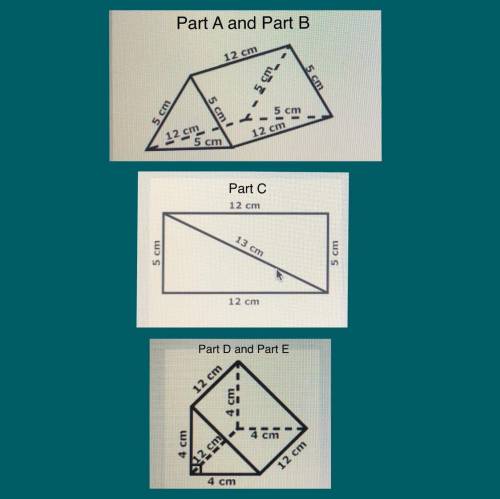
Mathematics, 28.04.2021 22:20 korban23
Please help me! Please! I am so lost! Pythagorean Theorem!
(The prism said to have an equilateral triangle base has the measurements shown)
Part A
Are the bases of the prism equilateral triangle‘s? Why or why not? Note: the bases of a triangular prism are triangles.
Part B
For this prism to be a right prism, all the lateral faces must be rectangles. Is enough information given to prove the lateral faces are rectangles? Why or why not?
Part C
Without using a protractor, you can determine whether the angles are right angles by measuring the length of the diagonal and applying the converse of the Pythagorean theorem.
The length of both diagonals for each lateral side is 13 cm. From this can you prove that the lateral sides are rectangles? Why or why not?
Part D
Some of the measurements of the triangular prism with a right angle base are shown. What is the length of the hypotenuse of the base?
Part E
Which lateral face has the largest area, the bottom one, left one, or diagonal one? What is the area?


Answers: 1


Other questions on the subject: Mathematics

Mathematics, 21.06.2019 14:30, lizisapenguin
Which of these people has balanced their checkbook correctly? oa. gary: the balance in his check register is $500 and the balance in his bank statement is $500. b. gail: the balance in her check register is $400 and the balance in her bank statement is $500. c. gavin: the balance in his check register is $500 and the balance in his bank statement is $510.
Answers: 2

Mathematics, 21.06.2019 17:00, JvGaming2001
Scarlet bought three pairs of sunglasses and two shirts for $81 and paula bought one pair of sunglasses and five shirts for $105 what is the cost of one pair of sunglasses and one shirt?
Answers: 2

Mathematics, 21.06.2019 19:50, Roshaan8039
Prove (a) cosh2(x) − sinh2(x) = 1 and (b) 1 − tanh 2(x) = sech 2(x). solution (a) cosh2(x) − sinh2(x) = ex + e−x 2 2 − 2 = e2x + 2 + e−2x 4 − = 4 = . (b) we start with the identity proved in part (a): cosh2(x) − sinh2(x) = 1. if we divide both sides by cosh2(x), we get 1 − sinh2(x) cosh2(x) = 1 or 1 − tanh 2(x) = .
Answers: 3

Mathematics, 21.06.2019 21:00, ambermcneil3839
Aquadrilateral has exactly one pair of parallel sides. which name best describes the figure?
Answers: 3
You know the right answer?
Please help me! Please! I am so lost! Pythagorean Theorem!
(The prism said to have an equilateral...
Questions in other subjects:


Mathematics, 14.07.2019 20:30







Health, 14.07.2019 20:30



